Rama Navami is a sacred Hindu festival. It celebrates the birth of Lord Rama, who stands for righteousness and devotion. In 2025, this special day is on April 6.
This day is the ninth day of Chaitra Navaratri. It is a time when good triumphs over evil for millions.
The most sacred time for rituals is Madhyahna Muhurat. It happens between 11:43 AM and 2:18 PM. Devotees think this is when Lord Rama was born. It’s the best time for prayers and offerings.
In India, celebrations are vibrant, with a focus on Ayodhya, Bhadrachalam, and Sitamarhi. Temples are filled with devotional songs. Grand processions unite communities. The festival mixes religious joy with cultural celebrations, showing the values of Lord Rama’s life.
What Is Rama Navami?
Rama Navami is rooted in ancient scriptures. It celebrates the birth of Lord Rama, the seventh incarnation of Lord Vishnu. His story, in Valmiki’s Ramayana, is key to Hindu philosophy.
The Divine Incarnation of Lord Rama
Rama was born in Ayodhya during the Treta Yuga. His life shows virtue and duty. As Vishnu’s avatar, he defeated the demon king Ravana, upholding dharma.
His teachings are for everyone because he was both divine and human.
Historical and Mythological Roots
Valmiki’s Ramayana tells Rama’s story. Ayodhya, his birthplace, is seen as a symbol of righteousness. He is called maryada purushottam (perfect man) for his moral code.
| Attribute | Significance |
|---|---|
| Incarnation | 7th avatar of Lord Vishnu |
| Birth | Treta Yuga, Ayodhya |
| Mission | Defeat Ravana, restore dharma |
| Scripture | Valmiki’s Ramayana |
Rama Navami 2025 Date and Muhurat
The festival’s date and rituals are based on celestial calculations. In 2025, it will be on April 6. Some places start on April 5 because of different lunar calendars.
The best time, Madhyahna Muhurat, is from 11:14 AM to 1:44 PM on April 6. This is when the sun and sunset times align with Lord Rama’s birth at 12:29 PM.
Key timings for major cities:
- Delhi: 11:15 AM – 1:45 PM
- Mumbai: 11:30 AM – 2:00 PM
- Chennai: 11:05 AM – 1:35 PM
DrikPanchang.com gives precise muhurat details for your area. The 1:00 PM time is very special, marking the divine arrival.
The Significance of Rama Navami in Hinduism
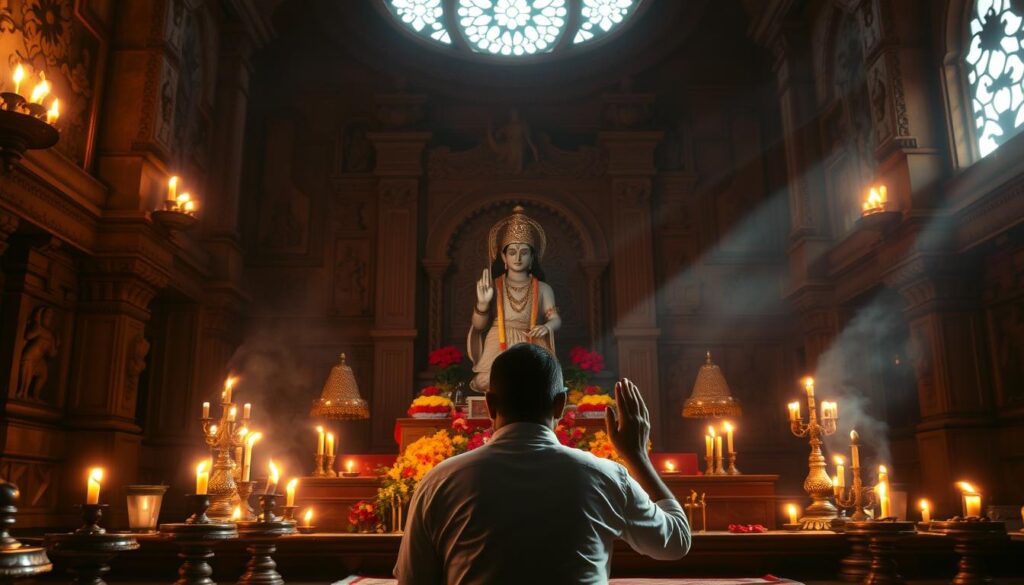
Rama Navami is a time of spiritual renewal in Hinduism. It ends Chaitra Navaratri, a nine-day period of devotion and purification. This festival shows the victory of good over evil, just like Lord Rama’s victory.
Lord Rama’s Teachings and Legacy
His life teaches us about righteousness and leadership. The Ramayana shows him as maryada purushottam, the perfect ruler. He balanced justice with kindness.
People follow his teachings by chanting and fasting. These actions bring inner peace. The nine-day sattvic diet cleanses body and mind.
Connection to Chaitra Navaratri
The festival happens in the sacred month of Chaitra. It connects with Navaratri’s themes. Each day honors a divine aspect, ending with Rama’s birth.
Ayodhya becomes a center of devotion with grand processions and hymns.
How Rama Navami Is Celebrated Across India
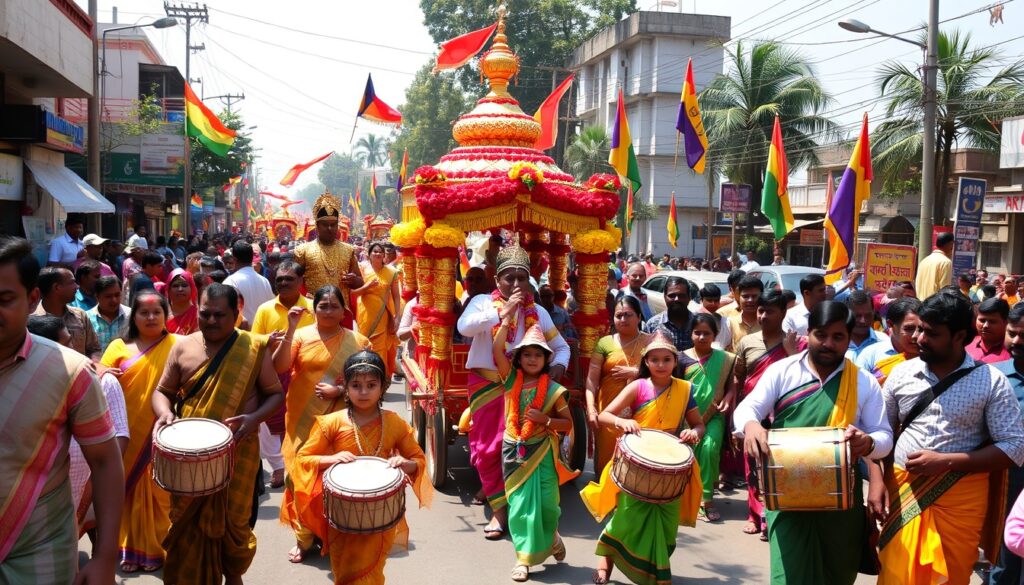
In India, Rama Navami brings Lord Rama’s story to life. From temple rituals to street processions, each place adds its own touch. This unites devotees in shared reverence.
Ayodhya: The Epicenter of Festivities
Ayodhya, Lord Rama’s birthplace, shines with decorated streets and grand chariots. The Ram Mandir is the heart of celebrations. Here, devotees pray and dip in the Sarayu River.
Regional Variations in Celebrations
In South India, Rameswaram’s temples celebrate with kalyanotsavam (divine marriage ceremonies). Sitamarhi’s Janaki Mandir honors Goddess Sita with flowers and songs.
Ramlila and Cultural Performances
Ramlila, a dramatic retelling of the Ramayana, captivates with music and dance. These performances teach about Rama’s victory over Ravana.
Traditional foods like panakam and kosambari show devotion. Festivals like Karnataka’s Ramaseva Mandali enrich the celebrations.
Rama Navami Puja Vidhi: Step-by-Step Rituals
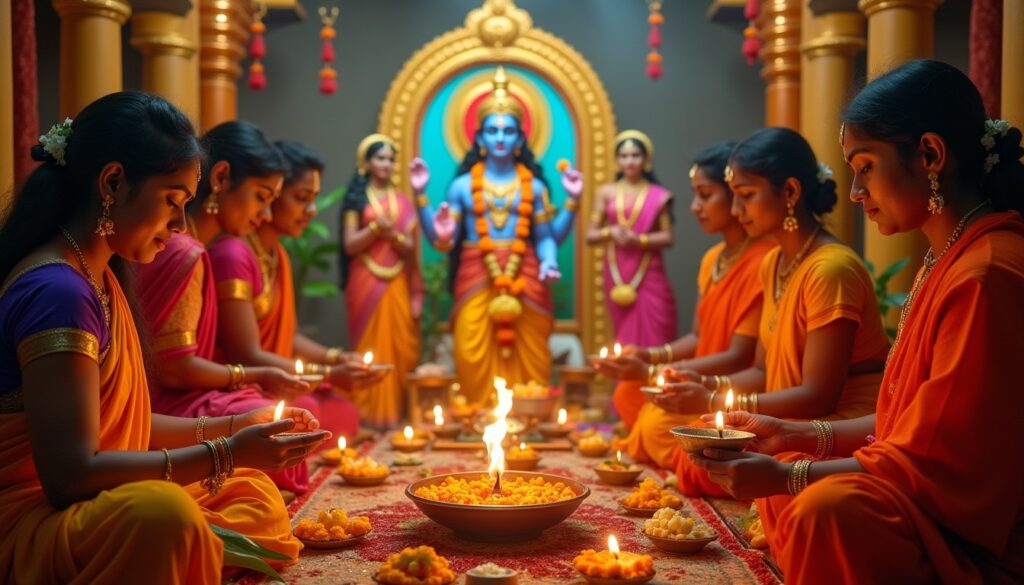
The puja vidhi follows ancient traditions. It starts with creating a sacred space for divine energy. Each step, from cleaning to chanting, connects us to Lord Rama’s teachings.
Preparing the Puja Space
Clean the altar with Gangajal and cover it with a yellow cloth. Place Rama, Sita, Lakshman, and Hanuman on a wooden chowki. Decorate with flowers, tulsi leaves, and incense.
Essential items include:
- Brass lamp with ghee or oil
- Kumkum, sandalwood paste, and turmeric
- Fruits, sweets, and coconut for prasad
Madhyahna Muhurat: The Auspicious Timing
The madhyahna muhurat is from 11:03 AM to 1:33 PM on April 6, 2025. It’s the time Lord Rama was born. To find the local time, divide the day into two parts. The middle part is the most sacred.
Here’s a sample schedule for shukla paksha:
| Time | Activity |
|---|---|
| 11:00 AM | Invoke Lord Ganesha |
| 11:30 AM | Meditate (dhyanam) |
| 12:29 PM | Offer prasad and chant *Sri Rama Jayam* |
| 1:00 PM | Perform aarti |
Chanting the Vishnu Sahasranamam or Ram Stotra brings blessings. End by sharing prasad with family. This shows unity and divine grace.
Fasting Rules and Traditions for Rama Navami
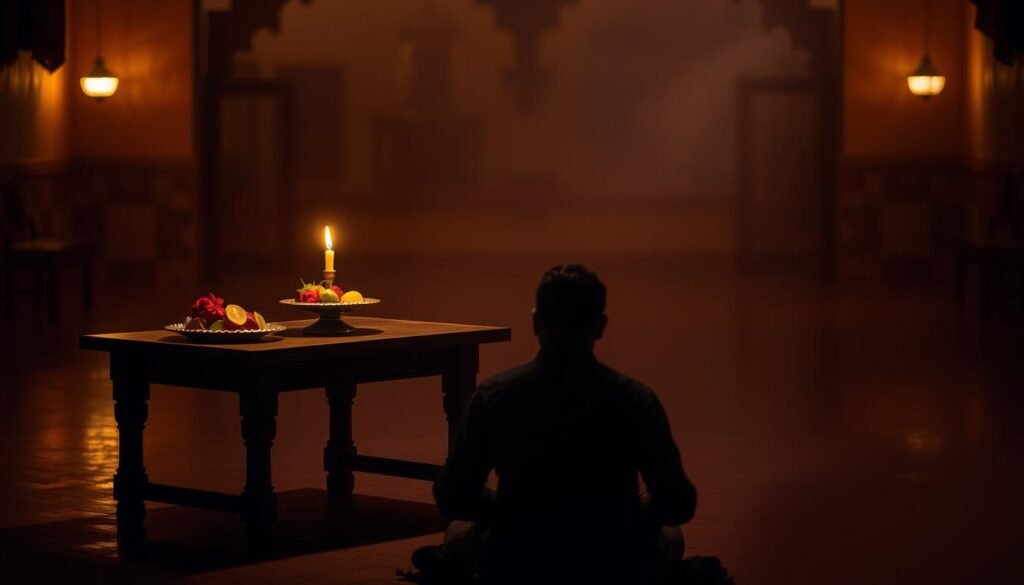
Fasting is very important during this time. Devotees don’t eat to clean their minds and bodies. They follow Lord Rama’s example. They can choose from strict nirjala fasts or lighter phalahara ones.
Types of Fasts Observed
There are three main fasting styles for the day:
| Fast Type | Description |
|---|---|
| Nirjala | No food or water until sunset |
| Phalahara | Fruits, milk, and nuts allowed |
| Partial | Sattvic meals like sabudana khichdi |
Most fast from sunrise to sunset. Some fast for eight prahar. Eating sattvic foods keeps energy up without losing focus.
Breaking the Fast: Rituals and Prasad
After sunset, devotees end their fast with prasad. Temples give out blessed food like panjiri or kheer. Families make panakam, a drink with jaggery and lemon, to refresh.
Recipe for Panakam:
- Mix 1 cup jaggery, 4 cups water, and 1 tsp ginger powder.
- Add a pinch of cardamom and lemon juice.
- Serve chilled with tulsi leaves.
Top Destinations to Experience Rama Navami 2025
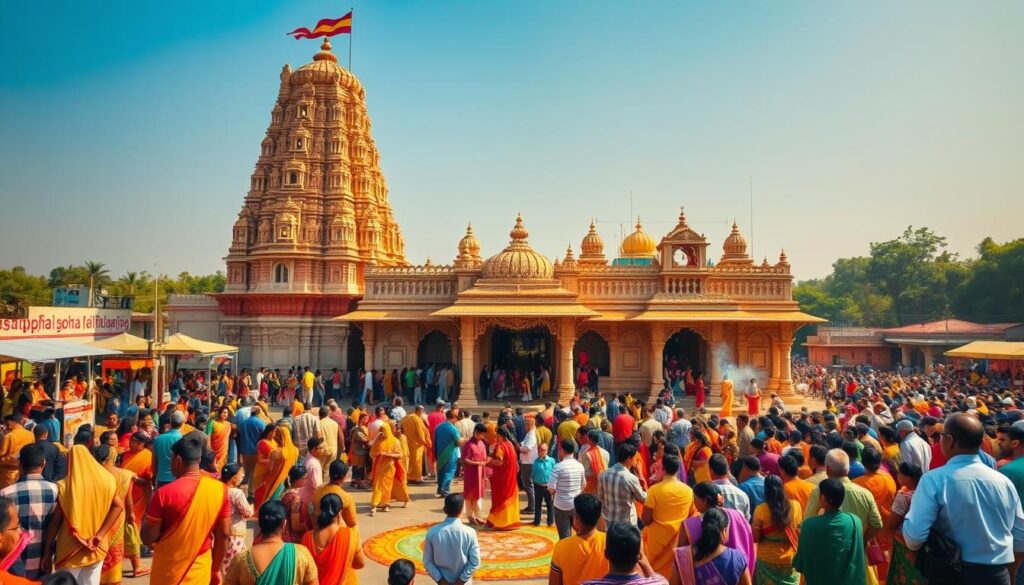
These places offer amazing celebrations. They have ancient temples and riverfront processions. Thousands of devotees come during the sacred month of Chaitra.
Ayodhya, Uttar Pradesh
Ayodhya is where Lord Rama was born. It becomes a spiritual center. The Ram Janmabhoomi temple has big abhishekam and aarti ceremonies. The Shobha Yatra procession is grand, with chariots and songs.
Travel Tip: Get there early for the midday muhurat rituals. Book your stay early because it gets very busy.
Bhadrachalam, Telangana
Bhadrachalam sits on the Godavari River. Its Rama temple shines with diyas. The Teppotsavam festival floats idols on barges, with Vedic chants.
Devotees gather to see this. It’s a special sight.
Hidden Gem: Don’t miss the Kodandrama Temple in Vontimitta. It’s quieter but just as meaningful.
Sitamarhi, Bihar
Sitamarhi is where Goddess Sita was born. Janaki Mandir reenacts her wedding to Lord Rama. The Sita Vivah Utsav has folk performances and a procession.
Local fairs offer handicrafts and sweets like thekua.
Pro Tip: Visit Punaura Dham too. It’s another important Ramayana site.
Rama Navami in the Modern Context

Technology has changed how we celebrate. Temples are key, but digital tools connect us worldwide. Live streams and apps like DrikPanchang make sure everyone can join in.
Community Gatherings and Digital Celebrations
Now, we have both local and online events. Families chant bhajans on Zoom. Social media shares Lord Rama’s life lessons with the young.
| Platform | Role |
|---|---|
| YouTube Live | Temple rituals broadcast globally |
| Storytelling through reels | |
| Community prayer groups |
Preserving Traditions for Future Generations
Youth are saving Ramayana stories. They face challenges like AI hymns. But DIY puppet shows and family stories keep the devotion alive.
These efforts keep Lord Rama’s incarnations alive for future generations. Tradition evolves but keeps its essence.
Embracing the Spirit of Rama Navami
This special day brings millions together. It celebrates values like compassion and integrity. These are important today.
Communities come together through temple visits and online satsangs. These traditions connect ages and keep culture alive.
Join local events or watch livestreams from Ayodhya. Simple acts like chanting mantras or sharing prasad deepen our connection.
Let Rama’s virtues inspire you. His legacy is in kindness and moral courage, not just rituals.

